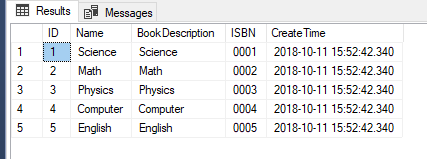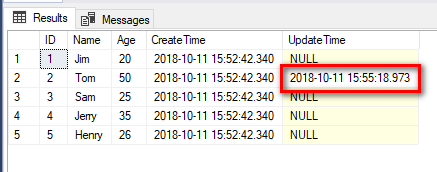ef mysql自动更新_EF Core中怎么实现自动更新实体的属性值到数据库
我们在开发系统的时候,经常会遇到这种需求数据库表中的行被更新时需要自动更新某些列。
数据库
比如下面的Person表有一列UpdateTime,这列数据要求在行被更新后自动更新为系统的当前时间。
Person表:
CREATE TABLE [dbo].[Person]([ID] [int] IDENTITY(1,1) NOT NULL,[Name] [nvarchar](50) NULL,[Age] [int] NULL,[CreateTime] [datetime] NULL,[UpdateTime] [datetime] NULL,CONSTRAINT [PK_Person] PRIMARY KEY CLUSTERED([ID] ASC)WITH (PAD_INDEX = OFF, STATISTICS_NORECOMPUTE = OFF, IGNORE_DUP_KEY = OFF, ALLOW_ROW_LOCKS = ON, ALLOW_PAGE_LOCKS = ON) ON [PRIMARY])ON [PRIMARY]
GO
ALTER TABLE [dbo].[Person] ADD CONSTRAINT [DF_Person_CreateTime] DEFAULT (getdate()) FOR [CreateTime]
GO
我们还有一个Book表,它没有UpdateTime列,那么这个表的数据在行更新时不要求自动更新任何列
Book表:
CREATE TABLE [dbo].[Book]([ID] [int] IDENTITY(1,1) NOT NULL,[Name] [nvarchar](50) NULL,[BookDescription] [nvarchar](100) NULL,[ISBN] [nvarchar](50) NULL,[CreateTime] [datetime] NULL,CONSTRAINT [PK_Book] PRIMARY KEY CLUSTERED([ID] ASC)WITH (PAD_INDEX = OFF, STATISTICS_NORECOMPUTE = OFF, IGNORE_DUP_KEY = OFF, ALLOW_ROW_LOCKS = ON, ALLOW_PAGE_LOCKS = ON) ON [PRIMARY])ON [PRIMARY]
GO
ALTER TABLE [dbo].[Book] ADD CONSTRAINT [DF_Book_CreateTime] DEFAULT (getdate()) FOR [CreateTime]
GO
那么Person表的UpdateTime列如果映射到了EF Core的实体上的话,有办法在Person实体被Update的时候自动设置为系统当前时间吗?答案是当然有!
EF Core 实体
首先我们将这两张表映射到EF Core的实体对象上:
Person实体:
public partial classPerson
{public int Id { get; set; }public string Name { get; set; }public int? Age { get; set; }public DateTime? CreateTime { get; set; }public DateTime? UpdateTime { get; set; }
}
Book实体:
public partial classBook
{public int Id { get; set; }public string Name { get; set; }public string BookDescription { get; set; }public string Isbn { get; set; }public DateTime? CreateTime { get; set; }
}
EF Core的DB First生成的DbContext类EFDemoContext
public partial classEFDemoContext : DbContext
{publicEFDemoContext()
{
}public EFDemoContext(DbContextOptionsoptions)
:base(options)
{
}public virtual DbSet Book { get; set; }public virtual DbSet Person { get; set; }protected override voidOnConfiguring(DbContextOptionsBuilder optionsBuilder)
{if (!optionsBuilder.IsConfigured)
{
optionsBuilder.UseSqlServer("Server=localhost;User Id=sa;Password=1qaz!QAZ;Database=EFDemo");
}
}protected override voidOnModelCreating(ModelBuilder modelBuilder)
{
modelBuilder.Entity(entity =>{
entity.Property(e=> e.Id).HasColumnName("ID");
entity.Property(e=> e.BookDescription).HasMaxLength(100);
entity.Property(e=>e.CreateTime)
.HasColumnType("datetime")
.HasDefaultValueSql("(getdate())");
entity.Property(e=>e.Isbn)
.HasColumnName("ISBN")
.HasMaxLength(50);
entity.Property(e=> e.Name).HasMaxLength(50);
});
modelBuilder.Entity(entity =>{
entity.Property(e=> e.Id).HasColumnName("ID");
entity.Property(e=>e.CreateTime)
.HasColumnType("datetime")
.HasDefaultValueSql("(getdate())");
entity.Property(e=> e.Name).HasMaxLength(50);
entity.Property(e=> e.UpdateTime).HasColumnType("datetime");
});
}
}
DbContext.ChangeTracker.StateChanged事件
之后最关键的一点到了,我们需要用到DbContext.ChangeTracker.StateChanged这个事件,这个事件会在DbContext中被Track的实体对象的EntityState状态发生变化时被触发,有多少个实体的EntityState状态变化了,它就会被触发多少次。
为此,我们需要再定义一个自定义的DbContext类EFDbContext,来继承DB First自动生成的EFDemoContext类:
//EFDbContext继承自EFDemoContext,EFDemoContext又继承自DbContext
public classEFDbContext: EFDemoContext
{publicEFDbContext()
{//设置数据库Command永不超时
this.Database.SetCommandTimeout(0);//DbContext.ChangeTracker.StateChanged事件,会在DbContext中被Track的实体其EntityState状态值发生变化时被触发
this.ChangeTracker.StateChanged += (sender, entityStateChangedEventArgs) =>{//如果实体状态变为了EntityState.Modified,那么就尝试设置其UpdateTime属性为当前系统时间DateTime.Now,如果实体没有UpdateTime属性,会抛出InvalidOperationException异常,所以下面要用try catch来捕获异常避免系统报错
if (entityStateChangedEventArgs.NewState ==EntityState.Modified)
{try{//如果是Person表的实体那么下面的Entry.Property("UpdateTime")就不会抛出异常
entityStateChangedEventArgs.Entry.Property("UpdateTime").CurrentValue =DateTime.Now;
}catch(InvalidOperationException)
{//如果上面try中抛出InvalidOperationException,就是实体没有属性UpdateTime,应该是表Book的实体
}
}//如果要自动更新多列,比如还要自动更新实体的UpdateUser属性值到数据库,可以像下面这样再加一个try catch来更新UpdateUser属性//if (entityStateChangedEventArgs.NewState == EntityState.Modified)//{//try//{//entityStateChangedEventArgs.Entry.Property("UpdateUser").CurrentValue = currentUser;//}//catch (InvalidOperationException)//{//}//}
};
}
}
然后我们在Program.cs的Main方法中(我在本例建立的是一个.Net Core控制台程序)先初始化Person表和Book表的数据,然后再修改Person表和Book表的数据,看看被修改的Person表数据其列UpdateTime的值是否设置为了系统当前时间:
classProgram
{//初始化Person表和Book表的数据
static voidInitializeDataToDB()
{var personJim = new Person() { Name="Jim", Age=20};var personTom= new Person() { Name = "Tom", Age = 30};var personSam = new Person() { Name = "Sam", Age = 25};var personJerry = new Person() { Name = "Jerry", Age = 35};var personHenry = new Person() { Name = "Henry", Age = 26};var bookScience = new Book() { Name = "Science", BookDescription= "Science", Isbn="0001"};var bookMath = new Book() { Name = "Math", BookDescription = "Math", Isbn = "0002"};var bookPhysics = new Book() { Name = "Physics", BookDescription = "Physics", Isbn = "0003"};var bookComputer = new Book() { Name = "Computer", BookDescription = "Computer", Isbn = "0004"};var bookEnglish = new Book() { Name = "English", BookDescription = "English", Isbn = "0005"};using (var efDbContext = newEFDbContext())
{
efDbContext.Person.Add(personJim);
efDbContext.Person.Add(personTom);
efDbContext.Person.Add(personSam);
efDbContext.Person.Add(personJerry);
efDbContext.Person.Add(personHenry);
efDbContext.Book.Add(bookScience);
efDbContext.Book.Add(bookMath);
efDbContext.Book.Add(bookPhysics);
efDbContext.Book.Add(bookComputer);
efDbContext.Book.Add(bookEnglish);
efDbContext.SaveChanges();
}
}static void Main(string[] args)
{
Console.WriteLine("Testing start!");//初始化Person表和Book表的数据
InitializeDataToDB();//修改Person表和Book表的数据
using (var efDbContext = newEFDbContext())
{//更改Person.Name为Tom的实体的Age属性值,这会导致personTom这个Person实体的EntityState变为Modified
Expression> expressionTom = p => p.Name == "Tom";var personTom =efDbContext.Person.First(expressionTom);
personTom.Age= 50;//更改Book.Name为Computer的实体的Isbn属性值,这会导致bookComputer这个Book实体的EntityState变为Modified
Expression> expressionComputer = b => b.Name == "Computer";var bookComputer =efDbContext.Book.First(expressionComputer);
bookComputer.Isbn= "1000";//由于上面DbContext中有两个实体的EntityState改变了,下面的SaveChanges方法会触发两次DbContext.ChangeTracker.StateChanged事件,在实体数据保存到数据库之前,自动更新personTom这个Person实体的UpdateTime属性值为系统当前时间
efDbContext.SaveChanges();
}
Console.WriteLine("Testing end!");
Console.ReadLine();
}
}
当执行完InitializeDataToDB方法后,数据库两张表的值:
Person表:
Book表:
当Program.cs的Main方法运行完毕后,数据库两张表的值:
Person表:
Book表:
我们可以看到Person表中列Name为Tom的行,其UpdateTime也被自动更新为了系统当前时间。这样数据库中所有带UpdateTime列的表,其UpdateTime列的值都会在EF Core中自动被更新,省去了很多冗余的代码。



